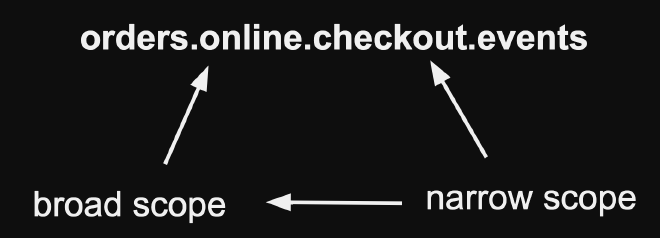Kafka Without Structure Is Just... Kafka

Table of Contents
How to name and manage topics.
The success of Event-Driven Architecture (EDA) isn’t just about getting the technology right—it’s also about how teams work together, both within their own boundaries and across organizational lines. It’s about shared models—built through meaningful naming, defined ownership, and a mutual understanding of what each topic represents.
EDA introduces powerful decoupling between systems, but that decoupling also demands alignment. In this post, we’ll focus on two critical pillars of that alignment: topic naming and ownership.
Organizational Considerations #
Topic Naming Convention #
There are 2 hard problems in computer science: cache invalidation naming things
As your system grows to dozens or even hundreds of topics, a clear and consistent naming convention becomes more than just a best practice—it becomes the foundation for a shared understanding.
A well-defined Topic Naming Convention, captured in an Architectural Decision Record (ADR), ensures that everyone knows what a topic represents, what kind of data it carries, and how it fits into the broader model. It’s a small investment that pays off in alignment, clarity, and long-term maintainability.
Name topics like you would name your domains (DNS) #
DNS provides an excellent model for structuring topic names. Just like domain names, topics could follow a hierarchical approach, moving from a broad scope (e.g., .com) to a more specific one, step by step.

This makes DNS-style naming a great foundation for a topic naming convention:
- Start with the broadest category and progressively narrow down.
- Use dots to separate different levels of specificity.
Domain Driven Design #
This approach aligns well with Domain Driven Design (DDD) principles, where you can start with the bounded-context and then move to the subdomains all to the way down to the aggregate root.
Example Naming Conventions: #

- E-commerce:
prd.orders.in-store.checkout.eventsprd.orders.online.checkout.eventsprd.orders.online.refund.statedev.products.inventory.eventsdev.customers.profile.events
- IoT
dev.iot.sensors.temperature.room.events
- Banking:
dev.transactions.creditcard.fraud-alert.events
Environment Prefix #
Even if you operate with a dedicated Kafka cluster per environment (e.g., dev, staging, prod), it’s still a good idea to include an explicit environment prefix in your topic names.
This small redundancy helps eliminate ambiguity and protects against costly mistakes—like accidentally producing or worse, deleting topics from the wrong environment.
Managing Topics #
Now we know how to name things it is time to discuss how to actually create those topics.
The Question of Ownership #
Who actually owns—or, put differently, takes responsibility for—the full lifecycle of a topic? In many organizations, this responsibility falls on a DevOps or infrastructure team. Often this stems from the fact that they are the ones who in the end are responsible for the cluster.
However, this seems counterintuitive when compared to a more familiar business application resource: the database table. Most teams manage their own database tables, using automated tools like Flyway or Liquibase within a deployment pipeline or at startup. Yet, when it comes to (Kafka) topics, this ownership model is rarely followed. Why is that?
The ultimate question is, who should be responsible for the full lifecycle of a topic?
To answer this question, you need to consider between two different approaches: Centralized Approach VS. Distributed Approach.
Centralized #
In a centralized model, topic management is handled through a single repository. Naturally, this repository brings up all kinds of wanted or unwanted coupling concerns.
🧷 Organizational Coupling: Changes to topics must go through a central team (like DevOps or Platform Engineering), introducing a process bottleneck. Application teams become dependent on this team for changes, which slows down development and increases friction and effectively creating organizational silos.
🚀 Deployment Coupling: Changes to topics need to be deployed together with the application code, which can lead to increased complexity and coordination overhead during deployments.
Summarized #
- ✅ Easier to enforce company-wide rules.
- ✅ Less complex when dealing with a small number of teams or services.
- ❌ Creates a bottleneck if the central team is unaware of specific use cases.
- ❌ Requires release coordination, making changes more convoluted and risky.
- ❌ Does not scale well as the number of teams and services grows.
Distributed Approach #
In a distributed model, topics are logically coupled to the code that uses them, allowing each team to manage their own topics.
🧷 Ownership and Autonomy: Each application team has full ownership and responsibility for the topics which they are master from and as such they produce on. This fosters autonomy, allowing teams to tailor topic configurations to their specific needs and iterate faster without depending on a central authority.
🚀 Decoupled Deployments: Topic changes are deployed as part of the application deployment lifecycle. This reduces the need for cross-team coordination and the risk of infrastructure changes blocking application releases. Teams can evolve their topics alongside their application code.
- ✅ Teams have full ownership and autonomy over their topics.
- ✅ Reduces dependencies on a central team, improving development speed.
- ✅ Allows for greater flexibility and customization based on specific needs.
- ✅ Scales well as the number of teams and services grows.
- ❌ Can lead to inconsistencies in naming conventions and configurations across teams.
- ❌ Requires each team to develop and maintain expertise in Kafka topic management.
- ❌ Makes it harder to enforce company-wide policies and standards consistently.
Each approach has its trade-offs, and the right choice depends on your organization’s size, structure, and priorities.
A successful Event-Driven Architecture isn’t just about choosing the right tools—it’s about aligning technical practices with team ownership and organizational structure. Whether centralized or distributed, what matters most is making the trade-offs explicit and intentional.